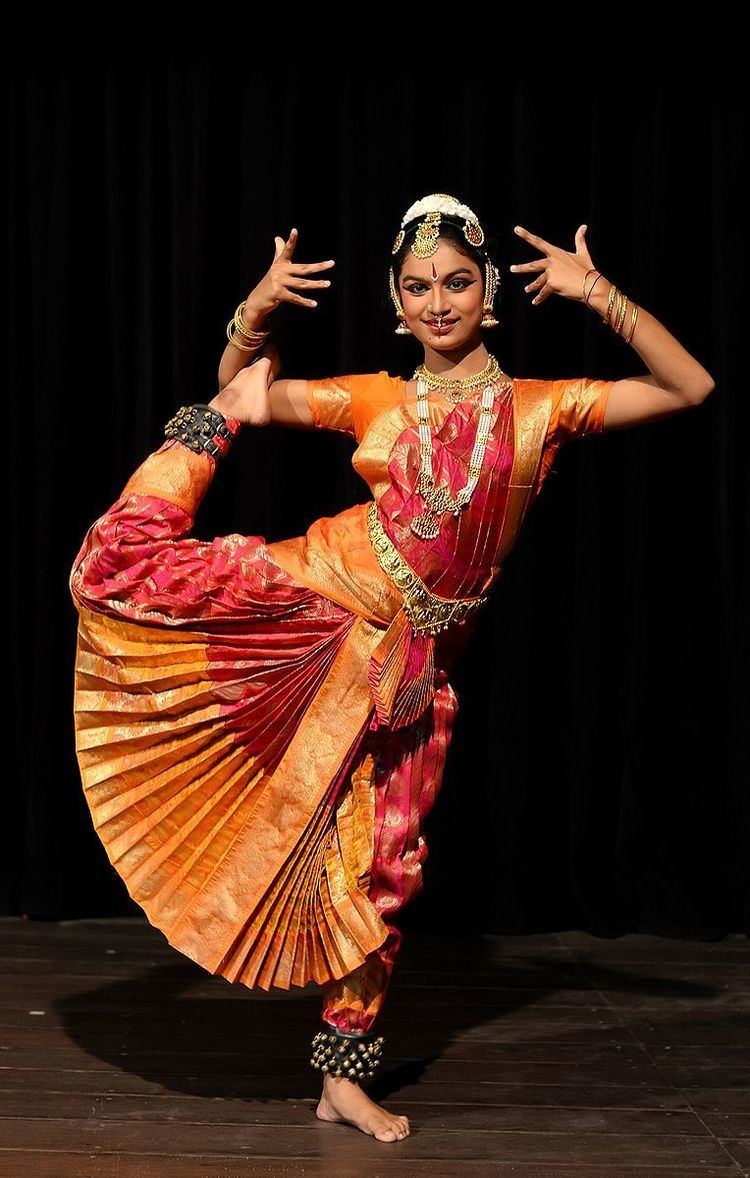 | ||
Indian classical dance, or Shastriya Nritya, is an umbrella term for various performance arts rooted in religious Hindu musical theatre styles, whose theory and practice can be traced to the Sanskrit text Natya Shastra.
Contents
The number of recognized classical dances range from eight to more, depending on the source and scholar. The Sangeet Natak Akademi recognizes eight – Bharatanatyam, Kathak, Kuchipudi, Odissi, Kathakali, Sattriya, Manipuri and Mohiniyattam. Scholars such as Drid Williams add Chhau, Yaksagana and Bhagavata Mela to the list. The Culture Ministry of the Government of India includes Chhau in its classical list. These dances have been regional, all of them include music and recitation in local language or Sanskrit, and they represent a unity of core ideas in a diversity of styles, costumes and expression.
Texts and roots
The Natya Shastra is the foundational treatise for classical dances of India, and this text is attributed to the ancient scholar Bharata Muni. Its first complete compilation is dated to between 200 BCE and 200 CE, but estimates vary between 500 BCE and 500 CE. The most studied version of the Natya Shastra text consists of about 6000 verses structured into 36 chapters. The text, states Natalia Lidova, describes the theory of Tāṇḍava dance (Shiva), the theory of rasa, of bhāva, expression, gestures, acting techniques, basic steps, standing postures – all of which are part of Indian classical dances. Dance and performance arts, states this ancient text, are a form of expression of spiritual ideas, virtues and the essence of scriptures.
While the Natya Shastra is the revered ancient text in the Hindu tradition, there are numerous other ancient and medieval Sanskrit dance-drama related texts that further discuss and expand on the classical repertoire of performance arts, such as the Abhinaya Darpana, Abhinaba Bharati, Natya Darpana, Bhava Prakasa and many others. The term "classical" (Sanskrit: "Shastriya") denotes the Natya Shastra-based performing arts.
The text Natya Shastra describes religious arts as a form as margi, or a "spiritual traditional path" that liberates the soul, while the folk entertainment is called desi, or a "regional popular practice".
Indian classical dances are traditionally performed as an expressive drama-dance form of religious performance art, related to Vaishnavism, Shaivism, Shaktism, pan-Hindu Epics and the Vedic literature, or a folksy entertainment that includes story-telling from Sanskrit or regional language plays. As a religious art, they are either performed inside the sanctum of a Hindu temple, or near it. Folksy entertainment may also be performed in temple grounds or any fairground, typically in a rural setting by traveling troupes of artists; alternatively, they have been performed inside the halls of royal courts or public squares during festivals.
Dance forms
The Natya Shastra mentions four Pravrittis (traditions, genres) of ancient dance-drama in vogue when it was composed – Avanti (Ujjain, central), Dakshinatya (south), Panchali (north, west) and Odra-Magadhi (Odisha-Bihar-Bengal, east).
Sources differ in their list of Indian classical dance forms. Encyclopædia Britannica mentions six dances. The Sangeet Natak Akademi has given recognition to eight Indian dances. The Indian government's Ministry of Culture includes eleven dance forms. Scholars such as Drid Williams and others include Chhau, Yaksagana and Bhagavata Mela to the eight classical Indian dances in the Sangeet Natak Akademi list.
The classical dance forms recognised by the Sangeet Natak Akademi and the Ministry of Culture are:
Shared aspects
All major classical Indian dance forms include in repertoire, three categories of performance in the Natya Shastra. These are Nritta, Nritya and Natya:
All classical dances of India used similar symbolism and rules of gestures in abhinaya (acting). The roots of abhinaya are found in the Natyashastra text which defines drama in verse 6.10 as that which aesthetically arouses joy in the spectator, through the medium of actor's art of communication, that helps connect and transport the individual into a super sensual inner state of being. A performance art, asserts Natyashastra, connects the artists and the audience through abhinaya (literally, "carrying to the spectators"), that is applying body-speech-mind and scene, wherein the actors communicate to the audience, through song and music. Drama in this ancient Sanskrit text, thus is an art to engage every aspect of life, in order to glorify and gift a state of joyful consciousness.
The communication through symbols is in the form of expressive gestures (mudras or hastas) and pantomime set to music. The gestures and facial expressions convey the ras (sentiment, emotional taste) and bhava (mood) of the underlying story. In Hindu classical dances, the artist successfully expresses the spiritual ideas by paying attention to four aspects of a performance: Angika (gestures and body language), Vachika (song, recitation, music and rhythm), Aharya (stage setting, costume, make up, jewelry), and Sattvika (artist's mental disposition and emotional connection with the story and audience, wherein the artist's inner and outer state resonates). Abhinaya draws out the bhava (mood, psychological states).
